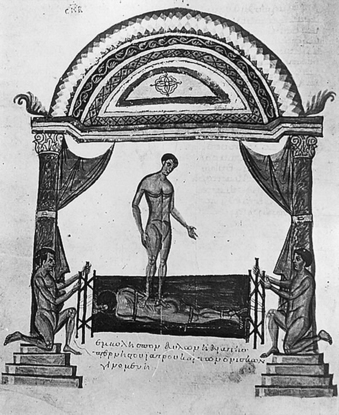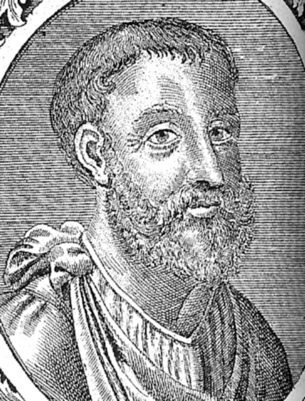Chapter 3 History of Spine Biomechanics
Preclassical Antiquity
The oldest known documents related to spine biomechanics were found in ancient Egypt and India. The Edwin Smith Papyrus—named after the American archeologist who purchased the scroll in 1862—is the only surviving copy of a portion of an Ancient Egyptian surgical text.1 The author is unknown, but postulated to be Imhotep, the well-known physician to the pharaoh. The surviving copy was scribed in 1700 bce, but the ideas represented date further back to at least the Egyptian Old Kingdom (2600–2200 bce).2,3 It contains the first reference to the concept of the spine as a bony column, termed the “djet” column.4 Among the 48 case presentations of trauma, 6 were cases of spine trauma. Not only does the papyrus contain descriptions of the devastating neurologic consequences of high cervical traumatic injury to the spinal cord, but it also details the first classification of spine trauma. Sehem represents vertebral axial failure (likely including both compression and burst fracture), whereas wenekh represents dislocation.3,5,6 Although there is evidence that the Egyptians understood the principle of reduction and immobilization for long bone fractures, they did not advocate treating spinal fractures due to the poor prognosis associated with them.
The oldest Indian reference available for spinal biomechanics is an ancient Hindu mythologic epic, Srimad Bhagwat Mahapuranam, written between 3500 bce and 1800 bce.7 The epic includes a description of Lord Krishna correcting the hunchback of one of his devotees by manually applying opposing axial forces on the lady’s chin and feet.8
Classical Antiquity
Mythologic Period
Homer’s Iliad contains several references to spinal trauma: “Hector with his sharp spear struck Eioneus on the neck below the well-made helmet of bronze, and loosed his limbs.”9 The Greek word translated into “loosed” or “lysed,” probably forms the basis for the development of the term paralysis.10 Empedocles reported data from his studies of the spine in the fifth century bce. He suggested that the vertebrae were initially unified, forming a rigid spine, and that this solid osseous column subsequently segmented into pieces as a result of movements of the body.11,12
Scientific Period
During the scientific period, people gradually became skeptical of the notion of supernatural influence upon diseases and treatments. Hippocrates, the most important figure of this period, is the first physician to reject prevailing superstitions and beliefs and define disease in terms of natural causes; according to him, disease was due to an imbalance of four main bodily fluids, or humors: yellow bile, black bile, blood, and phlegm.
Hippocrates (460–377 bce)
Hippocrates made a careful study of the anatomy and pathology of the spine,12–14 (Fig. 3-1) separating the spinal vertebrae into three parts. The first part included the vertebrae lying above the level of the clavicle (including C7). The second part included the 12 vertebrae at the chest that articulated with ribs, the third part the 5 vertebrae between the chest and pelvis.13 The sacrum and coccyx were not included as components of the spine by Hippocrates. Hippocrates also described the natural curvature of the cervical and lumbar portions of the spine (although the terms lordosis and kyphosis were not introduced until Galen in second century ce).15 He used the term ithioscoliosis to describe the natural curves of the spine in the sagittal plane.13
Hippocrates classified spinal disorders as follows: (1) kyphosis, including both traumatic and nontraumatic etiologies; (2) scoliosis; (3) burst fractures; (4) vertebral dislocations; and (5) fractures of the spinous processes.13 He cited spinal tuberculosis as the most common cause for kyphosis, noting that the severity of deformity was greater when it occurred before puberty. Hippocrates was the first to relate traumatic spinal deformities to causative force mechanisms. He found that traumatic kyphosis could result from forceful falls on the shoulder or buttock.5 He correlated burst fractures with axial loading of the spine. Ventral vertebral dislocation was often secondary to a large force applied to the back such as a fall from a height or a blow from a heavy object.5 Dorsal dislocations were rare, frequently fatal, and associated with severe abdominal injury.5 Given the spinal architecture, Hippocrates noted the extreme force needed to create a dislocation: “a great thrusting-out and rupture of the articulation of one or more of them does not very often occur, but is rare. Such injuries, indeed, are hard to produce.”13,16 He also noted that dislocations (which he termed inward curvatures vs. outward curvatures in kyphosis) were associated with a poor prognosis: “In such cases, then, retention of urine and faeces is more frequent than in outward curvatures; the feet and lower limbs as a whole more usually lose heat, and these injuries are more generally fatal. Even if they survive, they are more liable to incontinence of urine, and have more weakness and torpor of the legs; while if the incurvation occurs higher up, they have loss of power and complete torpor of the whole body.”13,16 He noted that isolated spinous process fractures did not result in deformity, healed well, and did not result in clinical impairment.
Beyond his keen observations, Hippocrates also devised several innovative therapeutic interventions for spinal disorders, including the Hippocratic board and the Hippocratic ladder. As a first line of intervention, he recommended manual traction of the spine with application of focal pressure using one’s hand or foot over a kyphotic deformity. If this did not work, he recommended use of the Hippocratic board, by which spinal traction could be better obtained using two opposing axial force vectors in combination with manual perpendicular force over the kyphotic deformity (Fig. 3-2). He liked this technique, as he states: “in accordance with nature; for the pressure forces the protruding parts into place, and the extensions according to nature draw asunder the parts that have come together.”13,16
Although he is credited with developing the Hippocratic ladder, his writings reflect less favorably upon this intervention. By this technique, a patient was fixed upside down on a ladder that was connected to a pulley system from which the ladder was raised, suddenly released, and allowed to fall to the ground, and repeated several times (Fig. 3-3). Hippocrates felt it was more difficult to control the direction and magnitude of force with this technique. Perhaps this is why he warned that this technique, which he called “succussion” (shaking), was better at pleasing the mob then correcting a deformity.17
Plato (427–347 bce)
The great philosopher and mathematician, Plato, was founder of the Academy in Athens, the first institution of higher learning in the Western world. He suggested that mathematics, a system of pure ideas, was the best tool for the pursuit of knowledge. Plato’s contributions to mathematics are considered to be the origins and stimulus for the development of the science of mechanics and, consequently, spine biomechanics.18
Aristotle (384–322 bce)
Aristotle provided treatises on many subjects, including physics, metaphysics, poetry, theater, music, politics, ethics, biology, and zoology.16 He should perhaps be considered the first biomechanist. As such, he recorded detailed information regarding the mechanical system of animals in his first book, De Motu Animalium (On the Movement of Animals).18–23 This work provides the first geometric analyses of isolated muscular movements such as flexion and extension.5 He commented on the rotational axes surrounding joints and how one type of motion, such as rotation, could be used to create another type, such as translation.
Aristotle discussed the problems of pushing a boat under various conditions from the standpoint of mechanics, describing, in a primitive form, Newton’s three laws of motion. Aristotle depicted a qualified understanding of the role of the center of gravity in his analyses of gait.23,24 Of note, Aristotle’s findings were purely observational, he did not perform scientific experiments. Even though his work was not directly related to the spine, Aristotle’s work led to the birth of kinesiology and laid further groundwork for spinal biomechanics.19,22
Herophilus of Chalcedon (335–280 bce)
Herophilus of Chalcedon, the world’s first anatomist, dominated the discussions of anatomic studies during this period. Although Herophilus carried out anatomic dissections on human cadavers, he did not comment on spine anatomy and biomechanics in his works. He did, however, make significant contributions to cerebral neuroanatomy and noted the consequences of spinal cord injuries, suggesting that direct surgical intervention on the spinal column should be avoided.11,25
Archimedes (287–212 bce)
Archimedes was a prominent mathematician, physicist, engineer, inventor, and astronomer of this age. He had the greatest influence on the future of spinal biomechanics through his contributions to theoretical mechanics in his work On the Equilibrium of Planes19 He is known for his formulation of the hydrostatic principle (known as Archimedes’ principle) and the development of the Archimedes screw, a cylinder with an internal revolving screw that was built to pump water against gravity. Archimedes described fundamental theorems concerning the center of gravity and laws of leverage.5
Galen of Pergamon (130–200 ce)
In the second century ce, as the Roman Empire rose to prominence, mysticism subsided and scientific thought regained credibility and popularity, albeit under the strict oversight of the Church. Galen (Fig. 3-4) was a physician to the Roman gladiators. More importantly, he made many important discoveries in anatomy and physiology by performing anatomic dissections on animals and extrapolating his findings to humans. Galen’s anatomic studies and interpretations affected medicine for more than a thousand years, until the time of Vesalius. His own work corroborated the findings of Imhotep and Hippocrates on the neurologic sequences of cervical trauma.14,24,26
Galen was the first to determine the reliance of muscular movements on supplying connections from nerves.27 He also demonstrated the neurologic implications following transection of the spinal cord at several levels in live animals. He dealt with spinal tuberculosis as well as an abundance of traumatic injuries to the spine and the spinal cord. He appreciated the structure of the spine in allowing an intersecting balance of neural protection and flexibility for mobility.27 Galen was able to detail the structure of the spine in that the vertebrae were joined ventrally and had articulating components dorsally. He felt that the former allowed for motion and the latter provided greater stability.5 In addition, he was the first to describe the spinal canal which contained the spinal cord—previously termed the “spinal marrow” in the Greek era. He noted that the spinal cord was an extension of the brain, “like a river having its springs in the brain.”27 He also used the Hippocratic board to treat kyphotic deformities, but unlike Hippocrates, advocated surgery in some cases to remove bony fragments impinging on the spine.5,25
Middle Ages (330–1453 ce)
Paulus of Aegina was the last prominent scientist working in the tradition of the Greco-Roman period.5 As the Dark Ages of Europe settled in, religion governed all aspects of life, particularly science. Yet during this same period, Islamic civilization flourished. Major Greco-Roman scientific texts were translated into Persian and Arabic, and many Islamic scientist physicians led the frontier of medical advancement.
Paulus of Aegina (625–690 ce)
The Medical Compendium in Seven Books or Epitomês Iatrikê Biblio Hepta was a medical treatise of seven books written by Paulus of Aegina in the seventh century (Fig. 3-5). He used traction tables to treat spinal deformity and employed a new technique of cauterization with a red hot iron to treat various painful illnesses. Paulus of Aegina was the first physician to perform a successful laminectomy for a spinal fracture with symptomatic neural compression. He recommended the use of orthoses for spinal fractures.25












